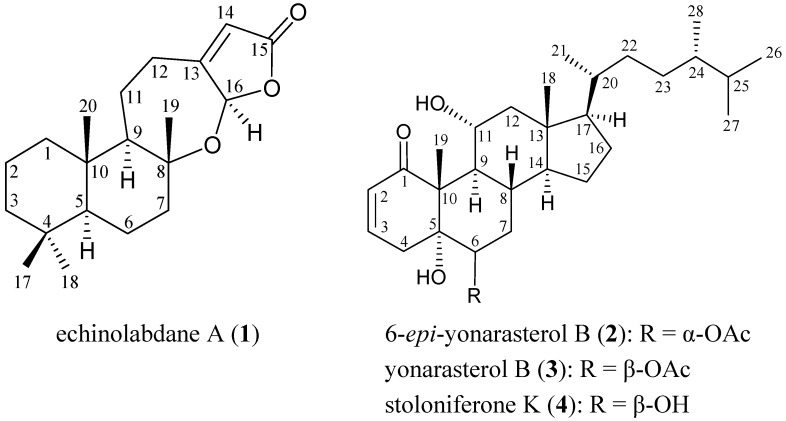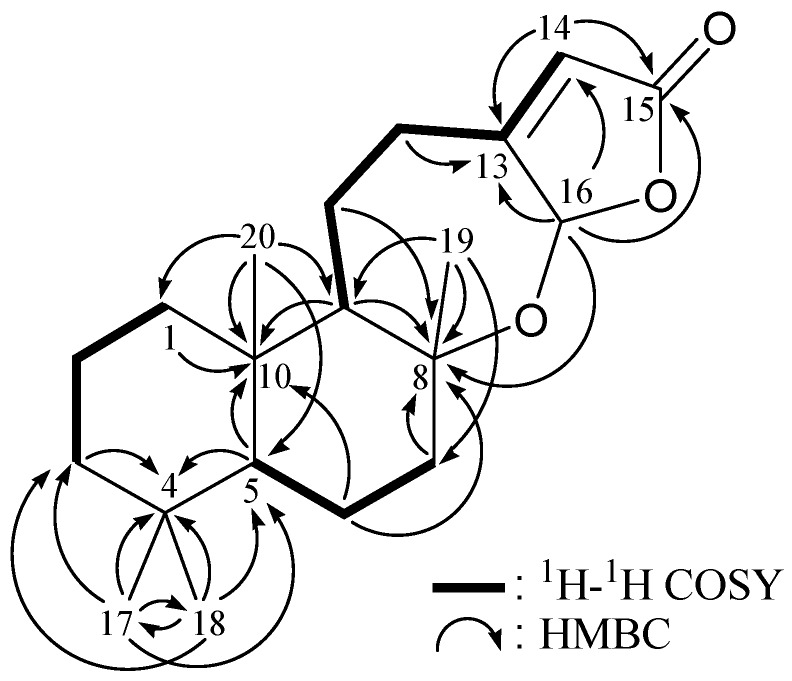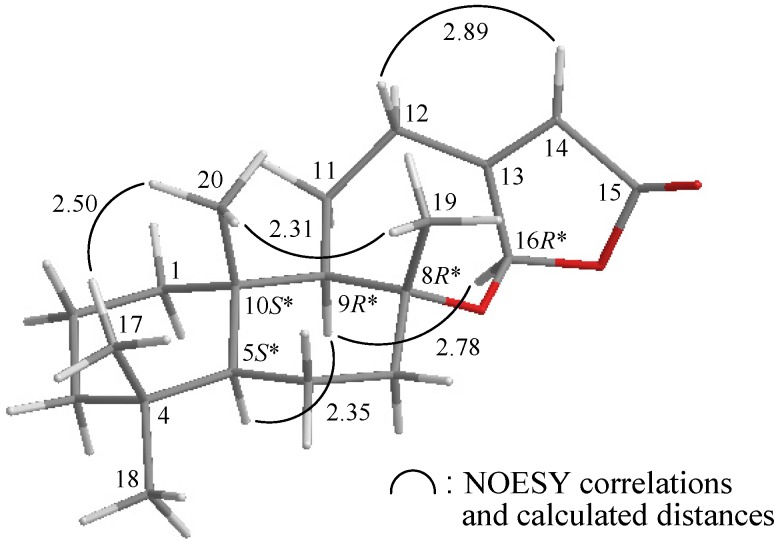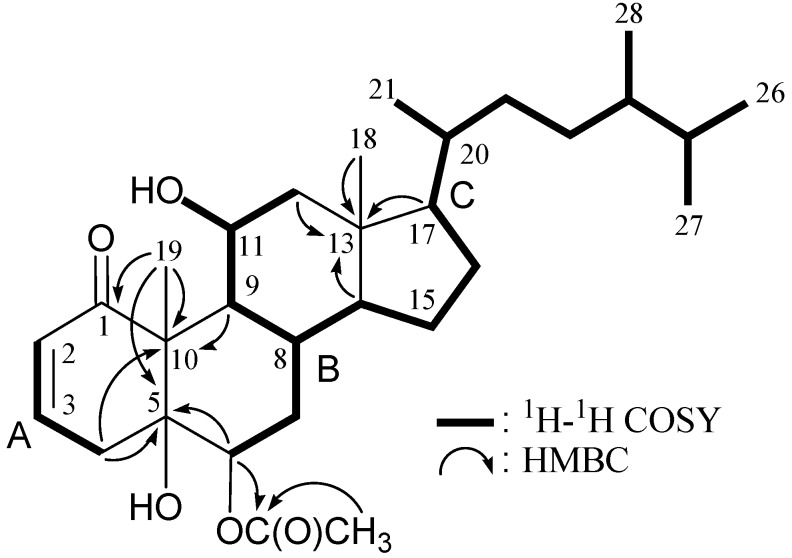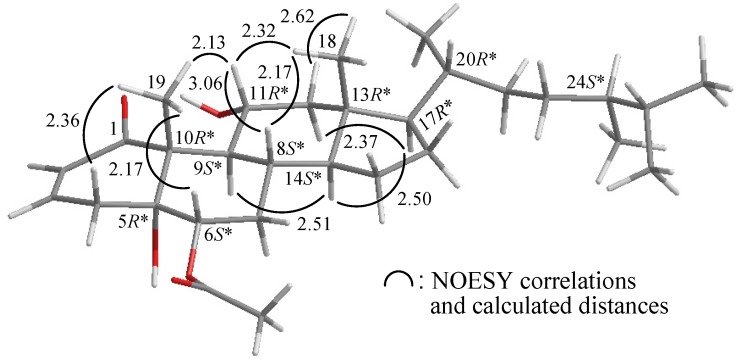Abstract
A new labdane-type diterpenoid, echinolabdane A (1), and a new sterol, 6-epi-yonarasterol B (2), were isolated from a gorgonian coral identified as Echinomuricea sp. The structures of metabolites 1 and 2 were elucidated by spectroscopic methods. Echinolabdane A (1) possesses a novel tetracyclic skeleton with an oxepane ring jointed to an α,β-unsaturated-γ-lactone ring by a hemiketal moiety, and this compound is the first labdane-type diterpenoid to be obtained from marine organisms belonging to the phylum Cnidaria. 6-epi-Yonarasterol B (2) is the first steroid derivative to be isolated from gorgonian coral belonging to the genus Echinomuricea, and this compound displayed significant inhibitory effects on the generation of superoxide anions and the release of elastase by human neutrophils.
Keywords: Echinomuricea, echinolabdane, yonarasterol, superoxide anion, elastase
1. Introduction
The search for new natural products from marine organisms has been remarkably successful, and gorgonian corals have been proven to be rich sources of interesting natural terpenoid derivatives [1,2]. In a previous study, two sesquiterpenoid phenols, (7S,10R)-(+)-10,11-epoxycurcuphenol and (+)-curcuphenol [3], were isolated from the Formosan gorgonian coral Echinomuricea sp. (family Plexauridae). In continuation of our search for new natural substances from marine invertebrates collected off the waters of Taiwan at the intersection point of the Kuroshio current and the South China Sea surface current, we have further isolated a new labdane-type diterpenoid, echinolabdane A (1), and a new steroid derivative, 6-epi-yonarasterol B (2), from Echinomuricea sp. In this paper, we describe the isolation, structural characterization and bioactivity of new compounds 1 and 2 (Figure 1).
Figure 1.
The structures of echinolabdane A (1), 6-epi-yonarasterol B (2), yonarasterol B (3) and stoloniferone K (4).
2. Results and Discussion
Echinolabdane A (1) was isolated as an oil, and the molecular formula for this compound was determined using HRESIMS to be C20H30O3 (6° of unsaturation) (m/z 341.2095 [M + Na]+, calculated as 341.2093). An IR absorption at 1765 cm−1 suggested the presence of a γ-lactone group in 1. The 13C NMR data for 1 confirmed the presence of 20 carbon signals (Table 1), which were characterized by DEPT as four methyls, seven sp3 methylenes, three sp3 methines, an sp2 methine, three sp3 quaternary carbons and two sp2 quaternary carbons. A suite of resonances at δC 170.6 (C-15), 169.3 (C-13), 117.0 (CH-14) and 100.9 (CH-16) could be assigned to the α,β-unsaturated-γ-lactone moiety. From the reported data, the carbon skeleton of 1 was suggested to be a diterpenoid derivative with four rings.
Table 1.
1H (400 MHz, CDCl3) and 13C (100 MHz, CDCl3) NMR data, 1H–1H COSY and HMBC correlations for diterpenoid 1.
| Position | δΗ (J in Hz) | δC, Mult. | 1H–1H COSY | HMBC (H→C) |
|---|---|---|---|---|
| 1a | 1.69 m | 40.6, CH2 | H-1b, H2-2 | C-10 |
| 1b | 1.91 m | H-1a, H2-2 | C-9 | |
| 2a | 1.45 m | 18.6, CH2 | H2-1, H-2b, H2-3 | n.o. |
| 2b | 1.63 m | H2-1, H-2a, H2-3 | n.o. | |
| 3a | 1.16 dd(13.6, 4.0) | 41.7, CH2 | H2-2, H-3b | C-4, -17 |
| 3b | 1.39 m | H2-2, H-3a | n.o. | |
| 4 | 33.4, C | |||
| 5 | 0.92 dd (9.6, 2.0) | 56.1, CH | H2-6 | C-4, -6, -10 |
| 6a | 1.29 m | 19.9, CH2 | H-5, H-6b, H2-7 | C-8, -10 |
| 6b | 1.72 m | H-5, H-6a, H2-7 | C-5, -8, -10 | |
| 7a | 0.94 m | 39.8, CH2 | H2-6, H-7b | C-6 |
| 7b | 1.78 br d (11.6) | H2-6, H-7a | C-8 | |
| 8 | 82.5, C | |||
| 9 | 1.38 m | 60.6, CH | H2-11 | C-8, -10, -11, -20 |
| 10 | 39.2, C | |||
| 11a | 1.51 m | 22.1, CH2 | H-9, H-11b, H2-12 | C-9 |
| 11b | 1.94 m | H-9, H-11a, H2-12 | C-8, -9 | |
| 12a | 2.22 m | 29.3, CH2 | H2-11, H-12b, H-14 | C-13, -14 |
| 12b | 2.91 ddd (13.6, 3.2, 2.4) | H2-11, H-12a | n.o. | |
| 13 | 169.3, C | |||
| 14 | 5.82 br s | 117.0, CH | H-12a | C-12, -13, -15, -16 |
| 15 | 170.6, C | |||
| 16 | 6.07 s | 100.9, CH | C-8, -13, -14, -15 | |
| 17 | 0.89 s | 33.4, CH3 | C-3, -4, -5, -18 | |
| 18 | 0.80 s | 21.4, CH3 | C-3, -4, -5, -17 | |
| 19 | 1.25 s | 22.3, CH3 | C-7, -8, -9 | |
| 20 | 0.78 s | 15.6, CH3 | C-1, -5, -9, -10 |
n.o. = not observed.
From the 1H–1H COSY analysis of 1 (Table 1 and Figure 2), it was possible to establish the spin systems that map out the proton sequences from H2-1/H2-2/H2-3, H-5/H2-6/H2-7, H-9/H2-11/H2-12 and H-12a/H-14 (by allylic coupling), which was accomplished with the assistance of an HMBC experiment (Table 1 and Figure 2). The key HMBC correlations between the protons and quaternary carbons of 1, including H-3a, H-5, H3-17, H3-18/C-4; H2-6, H-7b, H-9, H-11b, H-16, H3-19/C-8; H-1, H-5, H2-6, H-9, H3-20/C-10; H-12a, H-14, H-16/C-13; and H-14, H-16/C-15, permitted the elucidation of the carbon skeleton of 1. The tertiary methyls at C-4, C-8 and C-10 were confirmed by the HMBC correlations between H3-17/C-3, C-4, C-5, C-18; H3-18/C-3, C-4, C-5, C-17; H3-19/C-7, C-8, C-9; and H3-20/C-1, C-5, C-9, C-10. Furthermore, an HMBC correlation between H-16 (δH 6.07) and an oxygenated quaternary carbon at δC 82.5 (C-8) suggested the presence of a C-8/16 ether linkage in 1. The methine unit at δC 100.9 (CH-16) was more shielded than expected for an oxygenated C-atom and was correlated with the methine proton at δH 6.07 (H-16) in the HMQC spectrum, and this proton showed a 2J-correlation with C-13 and showed 3J-correlations with C-8, C-14 and C-15 in the HMBC spectrum, and was concluded to be a part of a hemiketal moiety.
Figure 2.
The 1H–1H COSY and selective key HMBC correlations for 1.
Figure 3.
The computer-generated model of 1 using MM2 force field calculations and the calculated distances (Å) between selected protons with key NOESY correlations.
The relative configuration of 1 was elucidated mainly from a NOESY spectrum as being compatible with that of 1 offered by computer modeling (Figure 3) [4], in which the close contacts of atoms in space calculated were consistent with the NOESY correlations. In the NOESY analysis of 1, the correlations of H-9 with H-5 and H-16, but not with H3-19 and H3-20, indicated that these protons (H-5, H-9 and H-16) were situated on the same face, and these were assigned as α protons, since the C-19 and C-20 methyls are β-substituents at C-8 and C-10, respectively. The Z-configuration of the C-13/14 double bond was elucidated from a correlation between H-14 (δH 5.82) and H-12b (δH 2.91). From the above evidence, the relative configurations of the chiral carbons of 1 were assumed to be 5S*, 8R*, 9R*, 10S* and 16R*. On the basis of the above findings, the structure of 1 was elucidated.
The in vitro cytotoxicity of labdane 1 was studied, and this compound exhibited weak cytotoxicity toward HL-60 (human acute promyelocytic leukemia) cells (IC50 = 19.1 μg/mL).
6-epi-Yonarasterol B (2) had a molecular formula of C30H48O5 as indicated by HRESIMS at m/z 511.3396 (calculated for C30H48O5Na, 511.3399). The 13C NMR and DEPT spectra of 2 exhibited the presence of seven methyls, seven sp3 methylenes, nine sp3 methines, two sp2 methines, three sp3 quaternary carbons and two sp2 quaternary carbons (Table 2). The IR spectrum of 2 showed absorptions due to α,β-unsaturated ketone (1671 cm−1) and ester (1732 cm−1) groups. The presence of a conjugated enone system in 2 was also indicated by 1H (δH 6.68, 1H, ddd, J = 10.5, 5.5, 2.5 Hz, H-3; 6.15, 1H, dd, J = 10.5, 2.0 Hz, H-2) and 13C (δC 205.8, C-1; 140.7, CH-3; 128.8, CH-2) NMR spectra (Table 2). The presence of a secondary acetoxy group was evident from the IR (1732 cm−1), 1H (δH 2.11, 3H, s, acetate methyl; 5.06, 1H, dd, J = 12.0, 5.5 Hz, H-6) and 13C (δC 21.2, acetate methyl; 171.5, acetate carbonyl; 75.1, CH-6) NMR spectra. IR absorption at 3392 cm−1 and 1H NMR signals at δH 3.91 (1H, br s, H-11) and 13C NMR at δC 66.9 (CH-11) indicated the presence of a secondary hydroxy group. It was found that the structure of 2 is similar to the structures of known sterols yonarasterol B (3) [5] and stoloniferone K (4) [6] (Figure 1). All C-H correlations of 2 were detected in the HMQC experiment. The 1H–1H COSY spectrum exhibited partial structures A, B and C (Table 2 and Figure 4). In the HMBC spectrum, the partial structure A could be connected to B through three quaternary carbons C-1, C-5, C-10 and Me-19 (Table 2 and Figure 4). Partial structure B could be connected to C through the remaining quaternary carbon C-13 and Me-18. Based on the above findings, the planar structure of 2 was concluded, as shown in Figure 4.
The configuration of two chiral centers (C-20 and C-24) in the side chain of 2 was elucidated by comparison of 13C NMR spectral data (δC 36.0, 39.0) with those of 3 (δC 36.3, 39.1) [5], 4 (δC 36.3, 39.1) [6]and (24S)-24-methylcholest-5-en-3β-ol (δC 36.26, 39.17) [7]. The configuration of the ring junctures in 2 was confirmed by NOESY analysis, as shown in Figure 5. The NOESY correlations between H-4β/Me-19; H-6/H3-19; H-8/H-11; H-8/Me-18; H-9/H-14; H-11/Me-18; H-11/Me-19; H-12β/Me-18; H-12α/H-17; and H-14/H-17 suggested that the 6-acetoxy and 11-hydroxy groups were α-oriented and all ring fusions in 2 were of a trans configuration. The coupling constants of H-6 and H-7a/b (J = 12.0, 5.5 Hz) suggested that H-6 was an axial hydrogen. This result further supported that the 6-acetoxy was α-oriented in 2. Due to the fact that coupling pattern of H-11 in 2 appeared as a broad singlet in the 1H NMR spectrum of 2, it is difficult to elucidate the relative stereochemistry of the 11-hydroxy group in 2 by vicinal coupling constant analysis; however, H-11 showed significant correlations with H-8, Me-18 and Me-19 in the NOESY analysis of 2, which suggested that the 11-hydroxy group in 2 was α-oriented.
Table 2.
1H (500 MHz, CDCl3) and 13C (125 MHz, CDCl3) NMR data, 1H–1H COSY and HMBC correlations for sterol 2.
| Position | δΗ (J in Hz) | δC,Mult. | 1H–1H COSY | HMBC (H→C) |
|---|---|---|---|---|
| 1 | 205.8, C | |||
| 2 | 6.15 dd (10.5, 2.5) | 128.8, CH | H-3 | n.o. |
| 3 | 6.68 ddd (10.5, 5.5, 2.5) | 140.7, CH | H-2, H2-4 | n.o. |
| 4a | 2.48 dd (20.5, 5.5) | 31.1, CH2 | H-3, H-4β | C-2, -3, -5, -10 |
| 4b | 2.91 br d (20.5) | H-3, H-4α | n.o. | |
| 5 | 78.4, C | |||
| 6 | 5.06 dd (12.0, 5.5) | 75.1, CH | H2-7 | C-5, -8, acetate carbonyl |
| 7a | 1.29 m | 33.8, CH2 | H-6, H-7b, H-8 | C-6, -8, -9 |
| 7b | 2.03 m | H-6, H-7a, H-8 | C-9 | |
| 8 | 1.27 m | 29.2, CH | H2-7, H-9, H-14 | n.o. |
| 9 | 1.62 m | 54.3, CH | H-8, H-11 | C-10 |
| 10 | 54.3, C | |||
| 11 | 3.91 br s | 66.9, CH | H-9, H2-12, OH-11 | n.o. |
| 12a | 1.13, m | 48.9, CH2 | H-11, H-12β | C-11, -13, -14, -17, -18 |
| 12b | 2.24 dd (12.5, 5.0) | H-11, H-12α | C-11, -13, -14, -17, -18 | |
| 13 | 43.1, C | |||
| 14 | 1.19 m | 54.9, CH | H-8, H2-15 | C-13, -18 |
| 15 | 1.57 m | 23.9, CH2 | H-14, H2-16 | n.o. |
| 16 | 1.31 m; 1.89 m | 28.1, CH2 | H2-15, H-17 | n.o. |
| 17 | 1.15 m | 55.9, CH | H2-16, H-20 | C-13, -18 |
| 18 | 0.67 s | 13.0, CH3 | C-12, -13, -14, -17 | |
| 19 | 1.34 s | 9.8, CH3 | C-1, -5, -9, -10 | |
| 20 | 1.32 m | 36.0, CH | H-17, H3-21, H2-22 | C-22 |
| 21 | 0.89 d (6.5) | 18.7, CH3 | H-20 | C-17, -20, -22 |
| 22a | 0.91 m | 33.5, CH2 | H-20, H-22b, H2-23 | C-20, -23, -24 |
| 22b | 1.37 m | H-20, H-22a, H2-23 | n.o. | |
| 23a | 0.93 m | 30.6, CH2 | H2-22, H-23b, H-24 | C-20, -22, -24 |
| 23b | 1.36 m | H2-22, H-23a, H-24 | C-22 | |
| 24 | 1.20 m | 39.0, CH | H2-23, H-25, H3-28 | C-22 |
| 25 | 1.56 m | 31.4, CH | H-24, H3-26, H3-27 | C-24, -26, -27, -28 |
| 26 | 0.85 d (7.0) | 20.5, CH3 | H-25 | C-24, -25, -27 |
| 27 | 0.78 d (6.5) | 17.6, CH3 | H-25 | C-24, -25, -26 |
| 28 | 0.77 d (6.5) | 15.4, CH3 | H-24 | C-23, -24, -25 |
| OH-11 | 1.74 d (4.0) | H-11 | n.o. | |
| 6-OAc | 171.5, C | |||
| 2.11 s | 21.2, CH3 | Acetate carbonyl |
n.o. = not observed.
Figure 4.
The 1H–1H COSY and selective key HMBC (protons→quaternary carbons) correlations for 2.
Figure 5.
The computer-generated model of 2 using MM2 force field calculations and the calculated distances (Å) between selected protons with key NOESY correlations.
The in vitro anti-inflammatory effects of compounds 1 and 2 were tested (Table 3). 6-epi-yonarasterol B (2) was found to show significant inhibitory effects on the generation of superoxide anions and the release of elastase by human neutrophils.
Table 3.
Inhibitory effects of compounds 1 and 2 on the generation of superoxide anions and the release of elastase by human neutrophils in response to FMLP/CB.
| Compounds | Superoxide Anions | Elastase Release | |||
|---|---|---|---|---|---|
| IC50 (µg/mL) | Inh % a | IC50 (μg/mL) | Inh % a | ||
| 1 | >10.0 | 2.52 ± 3.02 | >10.0 | 1.83 ± 3.46 | |
| 2 | 2.98 ± 0.29 | 89.76 ± 5.63 | 1.13 ± 0.55 | 95.54 ± 6.17 | |
| DPI b | 0.82 ± 0.31 | ||||
| Elastatinal b | 31.82 ± 5.92 | ||||
a Percentage of inhibition (Inh %) at a concentration of 10 µg/mL; b DPI (diphenylene indoniumn) and elastatinal were used as reference compounds.
3. Experimental Section
3.1. General Experimental Procedures
Optical rotations were measured on a Jasco P-1010 digital polarimeter. Infrared spectra were recorded on a Varian Diglab FTS 1000 FT-IR spectrophotmeter; peaks are reported in cm−1. The NMR spectra were recorded on a Varian Mercury Plus 400 or on a Varian Inova 500 NMR spectrometer. Coupling constants (J) are given in Hz. 1H and 13C NMR assignments were supported by 1H–1H COSY, HMQC, HMBC and NOESY experiments. ESIMS and HRESIMS were recorded on a Bruker APEX II mass spectrometer. Column chromatography was performed on silica gel (230–400 mesh, Merck, Darmstadt, Germany). TLC was carried out on precoated Kieselgel 60 F254 (0.25 mm, Merck) and spots were visualized by spraying with 10% H2SO4 solution followed by heating. Normal phase HPLC was performed using a system comprised of a Hitachi L-7100 pump, a Hitahci L-7455 photodiode array detector, a Rheodyne injection port and a normal phase column (Hibar 250 × 10 mm, Merck, silica gel 60, 5 μm). Reverse phase HPLC was performed using a system comprised of a Hitachi L-7100 pump, a Hitahci L-2455 photodiode array detector, a Rheodyne injection port and a reverse phase column (Polaris 5 C18-A 250 × 10 mm, Varian, silica gel 60, 5 μm).
3.2. Animal Material
Specimens of the gorgonian coral Echinomuricea sp. were collected by hand using scuba equipment off the coast of southern Taiwan and stored in a freezer until extraction. This organism was identified by comparison with previous descriptions [8,9]. A voucher specimen was deposited in the National Museum of Marine Biology and Aquarium, Taiwan.
3.3. Extraction and Isolation
The freeze-dried and minced material of Echinomuricea sp. (wet weight 1.68 kg, dry weight 428 g) was extracted with a mixture of methanol (MeOH) and dichloromethane (1:1). The residue was partitioned with ethyl acetate (EtOAc) and H2O. The EtOAc layer was partitioned between MeOH and n-hexane. The n-hexane layer was separated by silica gel and eluted using n-hexane/EtOAc/MeOH to yield 21 fractions A–U. Fraction L was separated on silica gel and eluted using n-hexane/EtOAc (stepwise, 50:1–pure EtOAc) to yield 16 fractions, L1–L16. Fraction L8 was purified by normal-phase HPLC using a mixture of n-hexane and EtOAc (8:1) as the mobile phase to afford compound 1 (0.9 mg). Fraction R was chromatographed on silica gel and eluted using n-hexane/EtOAc (stepwise, 1:1–pure EtOAc) to yield fractions R1–R13. Fraction R7 was separated by normal-phase HPLC using a mixture of n-hexane and acetone (4:1) as the mobile phase to afford 14 fractions R7A–R7N. Fraction R7M was further purified by reverse-phase HPLC using a mixture of methanol and H2O (85:15) to yield 2 (0.7 mg).
Echinolabdane A (1): yellowish oil; [α]23D +8 (c 0.03, CHCl3); IR (neat) νmax 1765 cm−1; 1H (CDCl3, 400 MHz) and 13C (CDCl3, 100 MHz) NMR data, see Table 1; ESIMS: m/z 341 [M + Na]+; HRESIMS: m/z 341.2095 (calcd. for C20H30O3Na, 341.2093).
6-epi-Yonarasterol B (2): white powder; mp 93–94 C; [α]25D −22 (c 0.05, CHCl3); IR (neat) νmax 3392, 1732, 1671 cm−1; 1H (CDCl3, 500 MHz) and 13C (CDCl3, 125 MHz) NMR data, see Table 2; ESIMS: m/z 511 [M + Na]+; HRESIMS: m/z 511.3396 (calcd. for C30H48O5Na, 511.3399).
3.4. Molecular Mechanics Calculations
Implementation of the MM2 force field [4] in CHEM3D PRO software from Cambridge Soft Corporation (Cambridge, MA, USA; ver. 9.0, 2005) was used to calculate the molecular models.
3.5. Cytotoxicity Testing
The cytotoxicity was assayed using a modification of the MTT [3-(4,5-dimethylthiazol-2-yl)-2,5-diphenyltetrazolium bromide] colorimetric method. Cytotoxicity assays were carried out according to previously described procedures [10,11].
3.6. Superoxide Anion Generation and Elastase Release by Human Neutrophils
Human neutrophils were obtained by means of dextran sedimentation and Ficoll centrifugation. Measurements of superoxide anion generation and elastase release were carried out according to previously described procedures [12,13]. Briefly, superoxide anion production was assayed by monitoring the superoxide dismutase-inhibitable reduction of ferricytochrome c. Elastase release experiments were performed using MeO-Suc-Ala-Ala-Pro-Valp-nitroanilide as the elastase substrate.
4. Conclusions
Labdane derivatives exist extensively in terrestrial plants [14], and compounds of this type have also been obtained from various marine organisms, including red algae belonging to the genus Laurencia [15,16,17,18,19]; sponges Chelonaplysilla erecta [20], Raspaciona aculeata [21], Agelas sp. [22]; and nudibranch Austrodoris kerguelensis [23]. It is worth noting that echinolabdane A (1) is the first labdane derivative to be isolated from marine organisms belonging to the phylum Cnidaria. The labdane analogue possessing a tetracyclic skeleton with an oxepane ring jointed to a γ-lactone ring by a hemiketal moiety, 1 (echinolabdane A), was discovered for the first time in this study. Furthermore, 6-epi-yonarasterol B (2) is the first steroid derivative to be isolated from a gorgonian coral belonging to the genus Echinomuricea, and this compound was found to exhibit significant anti-inflammatory activities. The gorgonian coral Echinomuricea sp. has begun to be transplanted in tanks for the extraction of natural products in order to establish a stable supply of bioactive material.
Acknowledgments
This research was supported by grants from the National Museum of Marine Biology and Aquarium (Grant No. 100100101 and 100200311); the National Dong Hwa University; the Division of Marine Biotechnology, Asia-Pacific Ocean Research Center, National Sun Yat-sen University (Grant No. 00C-0302-05); the National Research Program for Biopharmaceuticals, National Science Council, Taiwan (Grant No. NSC 100-2325-B-291-001 and 100-2325-B-039-005); and the Department of Health, Executive Yuan (DOH 101-TD-C-111-002 and 101-TD-C-111-004), Taiwan, awarded to Y.-C.W. and P.-J.S.
Footnotes
Samples Availability: Not available.
References
- 1.Blunt J.W., Copp B.R., Keyzers R.A., Munro M.H.G., Prinsep M.R. Marine natural products. Nat. Prod. Rep. 2012;29:144–222. doi: 10.1039/c2np00090c. [DOI] [PubMed] [Google Scholar]
- 2.Berrue F., Kerr R.G. Diterpenes from gorgonian corals. Nat. Prod. Rep. 2009;26:681–710. doi: 10.1039/b821918b. [DOI] [PubMed] [Google Scholar]
- 3.Chung H.-M., Hwang T.-L., Wang W.-H., Fang L.-S., Sung P.-J. Curcuphenol derivatives from the gorgonian Echinomuricea sp. Heterocycles. 2009;78:2595–2600. doi: 10.3987/COM-09-11771. [DOI] [Google Scholar]
- 4.Allinger N.L. Conformation analysis. 130. MM2. A hydrocarbon force field utilizing V1 and V2 torsional terms. J. Am. Chem. Soc. 1977;99:8127–8134. doi: 10.1021/ja00467a001. [DOI] [Google Scholar]
- 5.Iwashima M., Nara K., Iguchi K. New marine steroids, yonarasterols, isolated from the Okinawan soft coral, Clavularia virids. Steroids. 2000;65:130–137. doi: 10.1016/S0039-128X(99)00095-1. [DOI] [PubMed] [Google Scholar]
- 6.Duh C.-Y., Lo I.-W., Wang S.-K., Dai C.-F. New cytotoxic steroids from the soft coral Clavularia virids. Steroids. 2007;72:573–579. doi: 10.1016/j.steroids.2007.03.010. [DOI] [PubMed] [Google Scholar]
- 7.Wright J.L.C., McInnes A.G., Shimizu S., Smith D.G., Walter J.A., Idler D., Khalil W. Identification of C-24 alkyl epimers of marine sterols by 13C nuclear magnetic resonances spectroscopy. Can. J. Chem. 1978;56:1898–1903. doi: 10.1139/v78-308. [DOI] [Google Scholar]
- 8.Bayer F.M. Key to the genera of Octocorallia exclusive of Pennatulacea (Coelenterata: Anthozoa), with diagnoses of new taxa. Proc. Biol. Soc. Wash. 1981;94:902–947. [Google Scholar]
- 9.Fabricius K., Alderslade P. Soft Corals and Sea Fans—A Comprehensive Guide to the Tropical Shallow-Water Genera of the Central-West Pacific, the Indian Ocean and the Red Sea. 1st. Australian Institute of Marine Science; Queensland, Australia: 2001. pp. 59-60, 194-195. [Google Scholar]
- 10.Alley M.C., Scudiero D.A., Monks A., Hursey M.L., Czerwinski M.J., Fine D.L., Abbott B.J., Mayo J.G., Shoemaker R.H., Boyd M.R. Feasibility of drug screening with panels of human tumor cell lines using a microculture tetrazolium assay. Cancer Res. 1988;48:589–601. [PubMed] [Google Scholar]
- 11.Scudiero D.A., Shoemaker R.H., Paull K.D., Monks A., Tierney S., Nofziger T.H., Currens M.J., Seniff D., Boyd M.R. Evaluation of a soluble tetrazolium/formazan assay for cell growth and drug sensitivity in culture using human and other tumor cell lines. Cancer Res. 1988;48:4827–4833. [PubMed] [Google Scholar]
- 12.Yu H.-P., Hsieh P.-W., Chang Y.-J., Chung P.-J., Kuo L.-M., Hwang T.-L. 2-(2-Fluorobenz-amido) benzoate ethyl ester (EFB-1) inhibits superoxide production by human neutrophils and attenuates hemorrhagic shock-induced organ dysfunction in rats. Free Radic. Biol. Med. 2011;50:1737–1748. doi: 10.1016/j.freeradbiomed.2011.03.026. [DOI] [PubMed] [Google Scholar]
- 13.Hwang T.-L., Wang C.-C., Kuo Y.-H., Huang H.-C., Wu Y.-C., Kuo L.-M., Wu Y.-H. The hederagenin saponin SMG-1 is a natural FMLP receptor inhibitor that suppresses human neutrophil activation. Biochem. Pharmacol. 2010;80:1190–1200. doi: 10.1016/j.bcp.2010.06.028. [DOI] [PubMed] [Google Scholar]
- 14.Hanson J.R. Diterpenoids of terrestrial origin. Nat. Prod. Rep. 2011;28:1755–1772. doi: 10.1039/c1np90021h. [DOI] [PubMed] [Google Scholar]
- 15.Sims J.J., Lin G.H.Y., Wing R.M., Fenical W. Marine natural products. Concinndiol, a bromo-diterpene alcohol from the red alga, Laurencia concinna. J. Chem. Soc. Chem. Commum. 1973 [Google Scholar]
- 16.Howard B.M., Fenical W., Finer J., Hirotsu K., Clardy J. Neoconcinndiol hydroperoxide, a novel marine diterpenoid from the red alga Laurencia. J. Am. Chem. Soc. 1977;99:6440–6441. doi: 10.1021/ja00461a045. [DOI] [PubMed] [Google Scholar]
- 17.Howard B.M., Fenical W. Isoconcinndiol, a brominated diterpenoid from Laurencia snyderae var. guadalupensis. Phytochemistry. 1980;19:2774–2776. doi: 10.1016/S0031-9422(00)83968-0. [DOI] [Google Scholar]
- 18.Fukuzawa A., Miyamoto M., Kumagai Y., Abiko A., Takaya Y., Masamune T. Structure of new bromoditerpenes, pinnatols, from the marine red alga Laurencia pinnata Yamada. Chem. Lett. 1985;14:1259–1262. [Google Scholar]
- 19.Iliopoulou D., Mihopoulos N., Roussis V., Vagias C. New brominated labdane diterpenes from the red alga Laurencia obtusa. J. Nat. Prod. 2003;66:1225–1228. doi: 10.1021/np0301184. [DOI] [PubMed] [Google Scholar]
- 20.Rudi A., Kashman Y. Chelodane, barekoxide, and zaatirin-three new diterpenoids from the marine sponge Chelonaplysilla erecta. J. Nat. Prod. 1992;55:1408–1414. doi: 10.1021/np50088a004. [DOI] [Google Scholar]
- 21.Ciavatta M.L., Trivellone E., Cimino G., Uriz M.J. Chemical diversity in the Mediterranean sponge Raspaciona aculeata: Structure and absolute stereochemistry of blanesin. Tetrahedron Lett. 1994;35:7871–7874. [Google Scholar]
- 22.Nakamura H., Wu H., Ohizumi Y., Hirata Y. Agelasine-A, -B, -C and -D, novel bicyclic diterpenoids with a 9-methyladeninium unit possessing inhibitory effects on Na,K-ATPase from the Okinawan sea sponge Agelas sp. Tetrahedron Lett. 1984;25:2989–2992. [Google Scholar]
- 23.Davies-Coleman M.T., Faulkner D.J. New diterpenoic acid glycerides from the Antarctic nudibranch Austrodoris kerguelensis. Tetrahedron. 1991;47:9743–9750. doi: 10.1016/S0040-4020(01)80714-6. [DOI] [Google Scholar]



